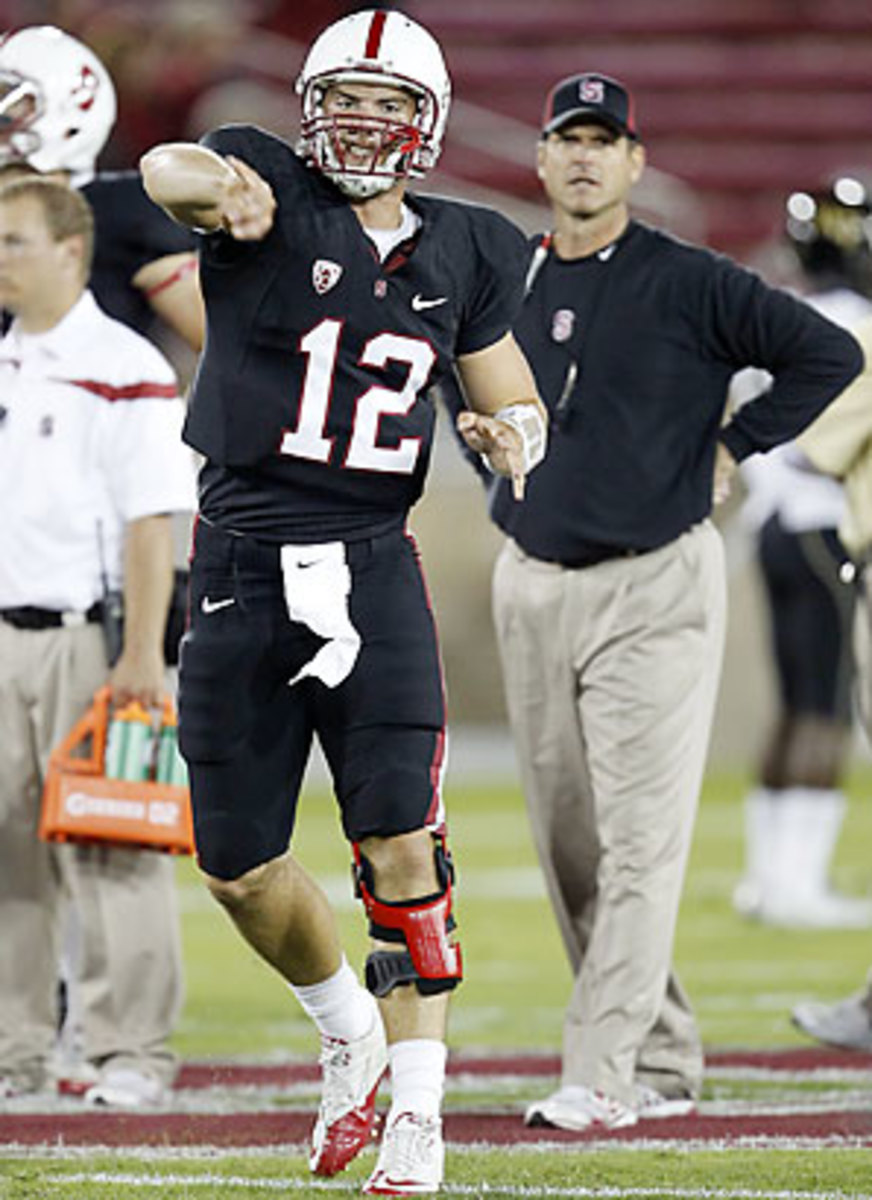Replacing Harbaugh poses new challenges to Stanford, candidates
The 2010 national championship is in the books. So it's time to handicap the contenders for next season.
Could Stanford really be one?
Stanford, arguably the best team that wasn't playing Monday night, has a leg up on the field already. Superstar quarterback Andrew Luck is returning next fall, thrusting the Cardinal into the preseason title conversation, a place it has never been before.
While Luck is returning to pursue his architectural engineering degree, he wouldn't mind pursuing a BCS title as well. We know what he's capable of -- Luck's talent put the quarterbacks in Monday's championship game to shame.
But to stay in the conversation, Stanford is going to have to hire the right coach to replace Jim Harbaugh. This is only the most important hire in the history of Stanford football, because the program has so much momentum.
Over the weekend Chris Petersen listened to Stanford but announced on Monday that he's staying at Boise State. The popular candidate among the players -- and the best bet for continuity -- is offensive coordinator David Shaw, a Stanford alum and former NFL coach. The rumor mill has churned out other names, including San Diego State's Brady Hoke, former Oregon coach Mike Bellotti and even former Stanford coach Tyrone Willingham, who lives in the Bay Area.
Athletic director Bob Bowlsby has a big decision to make, hiring Stanford's fourth coach in the past decade. But Bowlsby has choices. Because Stanford is suddenly a coveted job.
Harbaugh leaves a legacy of more than just a 12-1 team. He leaves tangible proof that football can succeed at Stanford and an institutional culture that has been changed by his success. Assistant coaches are now paid twice as much as they were a few years ago, housing help is available in pricey Palo Alto, the recruiting budget has been expanded, the admissions office is no longer viewed as the enemy. And the head coach is well compensated: Stanford paid Harbaugh roughly $1.5 million and was reportedly willing to double that to keep him.
But Stanford isn't like other schools. What a coach won't get if he heads to Stanford is:
1. Sellouts. Even during its remarkable 2010 season, Stanford only sold out one game, against USC. Its new stadium is small by many collegiate comparisons, holding just 50,000 fans, but it hasn't been small enough. The busy Bay Area offers too many options, and Stanford is a relatively small private school whose alumni scatter across the country, rather than remaining close by. However, the chance to see Luck next season may boost ticket sales.
2. A crown. The Pac-10 isn't the SEC and Stanford isn't Florida or Alabama. No one is going to kneel down and kiss the ring of a college coach -- even one who performs well. The Bay Area is a pro-oriented sports base and college tends to be an afterthought. Harbaugh moved a dozen miles down the freeway to where he has a shot to be the true sports king if he can turn around the 49ers.
(While there will be no crown, you do get a metaphorical throne. A few years ago, Harbaugh asked for and received his own private bathroom so that he would no longer have to walk down the hallway to use the facilities. So football coaches are catered to, to a certain extent.)
3. Blue-chippers at every position. Even with its newfound success, recruiting is a tricky proposition at Stanford. While the admissions office has a measure of flexibility that didn't exist six years ago, the academic bar is still set extremely high. There is tension -- many call it a healthy tension -- between academics and athletics. Most on the Stanford campus are excited about the football team, but plenty of professors are decidedly ambivalent or even hostile.
On the other hand, Stanford's new coach will get:
• A beautiful campus.
• Great facilities with perhaps more on the way. Stanford's stadium was renovated in 2006 and now there is talk of a football-only facility on campus.
• A welcoming environment, as opposed to the apathy that surrounded football in recent years.
• A generous benefactor in deep-pocketed booster John Arrillaga, who refurbished the stadium and wants Stanford sports to succeed.
• Smart players who are more likely to steal computer engineering code than laptop computers.
• Andrew Luck.
Luck is the prize for whoever takes the job. One year with Luck opens up a world of possibilities.
Luck may push for continuity -- and his voice will be heard. But Harbaugh leaves huge shoes behind, not just in coaching but also recruiting. Harbaugh promised "an enthusiasm unknown to mankind," and his forceful personality, combined with the lure of a Stanford degree, proved a potent recruiting combination. Stanford is losing eight starters on offense and seven on defense. It has commitments from several top recruits and wants to hold onto them.
Bowlsby will have to weigh continuity versus a big-name that could take Stanford into the next era. He'll want a coach who stays around -- Harbaugh was always headed to the NFL -- and Bowlsby will try to avoid hiring a coach who views Stanford only as a stepping-stone.
The last time Stanford had any kind of momentum at all, when Willingham left for Notre Dame two years after taking Stanford to the Rose Bowl, the university whiffed on its hire, employing Buddy Teevens. Teevens was followed by the equally unimpressive Walt Harris. When Bowlsby hired Harbaugh in '07 from University of San Diego, Stanford was a 1-11 bottom-feeder and Bowlsby didn't have much to sell a hot prospect.
It's different this time.
This is a big hire. Only the most important in the history of the program.






